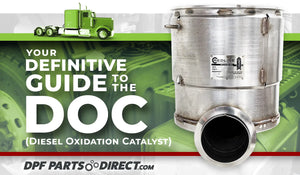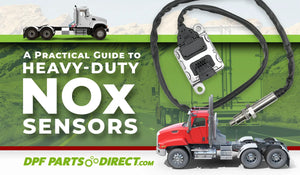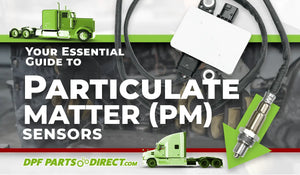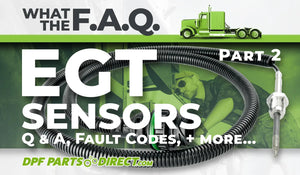Fleets of commercial trucks and owner-operators have been struggling to maintain and repair aftertreatment systems for over 15-years. It has been a source of frustration and a financial burden.
Our parent company, Diesel Emissions Service, has been providing aftertreatment maintenance and repairs since 2006 and in that time their technicians have observed two main factors that are driving the problems with aftertreatment today
Factor 1: A Lack of Accurate Information and Support
Having accurate information about how and when diesel emissions systems require maintenance and repairs is the key to avoiding many of the problems that fleets experience. However, that is what has been missing since the very beginning.

Insufficient Training
The independent service channel has not received adequate training from the very beginning. When diesel mechanics had to diagnose and repair pre-emissions vehicles, they knew how to troubleshoot known smoke issues.
With the 2007 and newer vehicles, these mechanics had to become technicians and really learn and understand the new technology to be able to diagnose the systems. As far as the DPF or aftertreatment goes, in 2007, fleets were kind of thrown into a tailspin with downtime and costs attributed to the aftertreatment system and they never were able to figure it out.
A Lack of Support
Part of the reason for this is the OE service channel has purposely made the information unavailable. They really don’t want the independent service channel to do the work, they want the vehicle brought back to the dealer.
The fleets had a belief that the OEM or the vehicle make that they had purchased, would keep them in the loop for training and would let them know what their service intervals should be. In 2007, almost every truck manufacturer and engine manufacturer basically said, “Look, the aftertreatment systems are going to last 500,000 to 600,000 miles. Don’t worry about them.” This wasn’t the case and it turned out to be a lot more complicated and expensive than anyone could have imagined.
Factor 2: Understanding the Aftertreatment System
There are four components to the aftertreatment system, and it is important to understand what they are and the function that they perform. This basic information provides the foundation for the maintenance system and diagnostic and repair criteria that keep fleets from experiencing rising costs and unscheduled downtime caused by premature aftertreatment failures.

Exhaust Gas Recirculation (EGR)
The ERG is an emission control technology that reduces NOx emissions from most diesel engines.
How it works:
Engine manufacturers know that if they can lower cylinder temperature during the combustion process, they will lower the amount of NOx created. The EGR removes a portion of the oxygen and replaces it with an inert gas. Those inert gases lower the cylinder temperatures. The EGR cooler (or coolers depending on which engine we’re talking about) lowers exhaust temperature before it’s reintroduced into the intake manifold.
Diesel Oxidation Catalyst (DOC)
The DOC is designed to convert carbon monoxide and hydrocarbons into carbon dioxide and water. It essentially breaks down pollutants in the exhaust system from a diesel engine which helps reduce particulate matter.
How it works:
The exhaust flows straight through the DOC substrate with very little restriction. In the aftertreatment system, there is a hydrocarbon dosing system where fuel is dosed at a specific temperature; the fuel turns into a vapor and that vapor starts the chemical reaction which produces heat. The ECM has a thermal management system where it maintains that heat and this process is all for the DPF.
Diesel Particulate Filter (DPF)
The DPF is an exhaust device that traps particulate matter such as soot and ash.
How it works:
Unlike the DOC, which is designed to be flow-through, the DPF is a wall-flow which means the exhaust flows into the filter through pores, and the soot and ash collect on the walls of the filter. The DPF has two jobs, catch soot and store ash.
Selective Catalytic Reduction (SCR)
The SCR is an advanced active emissions control technology system that injects a liquid-reductant agent through a special catalyst into the exhaust stream of a diesel engine. The reductant source is usually Diesel Exhaust Fluid (DEF).
How it works:
The SCR is also a NOx reduction technology, and its job is to lower engine outlet NOx to as close to zero as possible. The SCR is a flow-through technology a lot like the DOC. It injects diesel exhaust fluid which is 67.5% water and 32.5% urea and when the water evaporates, the remaining urea converts to ammonia and the ammonia reacts with the NOx and coverts it into nitrogen and water.
These four parts of the aftertreatment system work together and have allowed truck and engine manufacturers to meet the Environmental Protection Agency mandates. There are even more regulations and further reductions in how much NOx diesel engines will be permitted to emit in 2027. Therefore, the systems are here to stay.
The Key to Aftertreatment System Maintenance
One of the most common mistakes fleets make is failing to service the aftertreatment systems often enough. DPFs require regular cleaning, and the rest of the system requires regular inspections. Upstream leaks in the system are often the cause of downstream failures. The most common mistake diesel technicians make when diagnosing problems and performing repairs is to look at one part of the system instead of the four parts that make up the complete system. For example, the DPF is often blamed as the source of the problem when it is the symptom of a problem elsewhere in the system.
We hope you found this article informative and helpful. Keep DPF Parts Direct in mind next time one of your trucks is in need of aftertreatment parts. We have seasoned parts experts on hand to help you with any questions on part compatibility or availability.
========
This article was originally published by Diesel Emissions Service










Comments 0